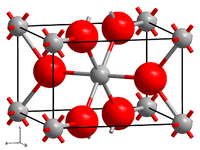Ruthenium (IV) oxide
| Crystal structure | |||||||||||||||||||
|---|---|---|---|---|---|---|---|---|---|---|---|---|---|---|---|---|---|---|---|

|
|||||||||||||||||||
| __ Ru 4+ __ O 2− | |||||||||||||||||||
| General | |||||||||||||||||||
| Surname | Ruthenium (IV) oxide | ||||||||||||||||||
| other names |
Ruthenium dioxide |
||||||||||||||||||
| Ratio formula | RuO 2 | ||||||||||||||||||
| Brief description |
blue-black, odorless powder |
||||||||||||||||||
| External identifiers / databases | |||||||||||||||||||
|
|||||||||||||||||||
| properties | |||||||||||||||||||
| Molar mass | 133.07 g mol −1 | ||||||||||||||||||
| Physical state |
firmly |
||||||||||||||||||
| density |
6.97 g cm −3 |
||||||||||||||||||
| Melting point |
> 955 ° C |
||||||||||||||||||
| solubility |
practically insoluble in water |
||||||||||||||||||
| safety instructions | |||||||||||||||||||
|
|||||||||||||||||||
| Toxicological data | |||||||||||||||||||
| Thermodynamic properties | |||||||||||||||||||
| ΔH f 0 |
−305 kJ mol −1 |
||||||||||||||||||
| As far as possible and customary, SI units are used. Unless otherwise noted, the data given apply to standard conditions . | |||||||||||||||||||
Ruthenium (IV) oxide is a chemical compound of ruthenium from the group of oxides .
Extraction and presentation
Ruthenium (IV) oxide can be obtained, for example, by hydrolysis of ruthenium halides (e.g. ruthenium (III) chloride ).
Single crystals of the oxide can be produced using a CVT (Chemical Vapor Transport) method . To do this, ruthenium sponge is first converted into polycrystalline oxide in a stream of oxygen at 1000 ° C. This oxide is then converted into a volatile oxide in a 3-zone furnace in a stream of oxygen at 1190 ° C, which then decomposes again into oxygen and ruthenium (IV) oxide in a colder region of the pipe at 1090 ° C, whereby 3 up to 4 mm large single crystals of the target compound arise. A reaction time of about 15 days is required for the conversion of 2 g of the polycrystalline starting material.
properties
Anhydrous ruthenium (IV) oxide is blue-black and odorless. It has a rutile crystal structure. There is also a black, hydrated form, which separates water of crystallization above 75 ° C.
use
Ruthenium (IV) oxide is used for the coating of titanium - Anodes , such as, for example, the chlor-alkali electrolysis used are required, and in the electronics industry. In addition, ruthenium oxide is used in resistance thermometers for extremely low temperatures.
It is also used in the field of microelectronics as an active substance in resistor pastes for thick-film technology .
Individual evidence
- ↑ a b D. B. Rogers et al .: Single crystals of transition-metal dioxides - A. Ruthenium and iridium dioxides . In: FA Cotton (Ed.): Inorganic Syntheses . tape 13 . McGraw-Hill Book Company, 1972, ISBN 0-07-013208-9 , pp. 135-145 (English).
- ↑ a b c d e f g Entry on ruthenium (IV) oxide in the GESTIS substance database of the IFA , accessed on January 8, 2020(JavaScript required) .
- ^ AF Holleman , N. Wiberg : Inorganische Chemie . 103rd edition. Volume 2: Subgroup elements, lanthanoids, actinides, transactinides. Walter de Gruyter, Berlin / Boston 2016, ISBN 978-3-11-049590-4 , p. 1975 (reading sample: Part C - Subgroup elements. Google book search ).
- ↑ H. Schafer: Z.an.allg. Chem. 319, 1963, p. 327.
- ^ RWG Wyckoff: Crystal Structures. Vol. 1, Interscience / John Wiley & Sons, 1963.
- ^ AF Wells: Structural Inorganic Chemistry. 4th edition. Clarendon Press, Oxford 1975.
- ↑ O. De Nora: Chem. Eng. Techn. 42, 1970, p. 222.
- ^ GS Iles: Platinum Met. Rev. 11, 1967, p. 126.
- ↑ A low noise thermometer readout for ruthenium oxide resistors . In: Review of scientific instruments . tape 73 , no. October 10 , 2002 ( nasa.gov [PDF; 186 kB ; accessed on August 4, 2011]).
- ↑ Prof. Dr.-Ing. Karlheiz Bock: thick film technology. (PDF) In: Faculty of Electrical Engineering at the Technical University of Dresden. TU Dresden, October 1, 2014, accessed on February 18, 2019 .


